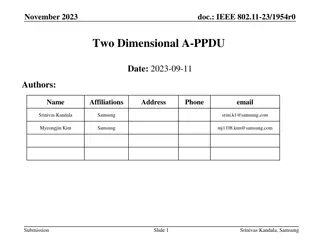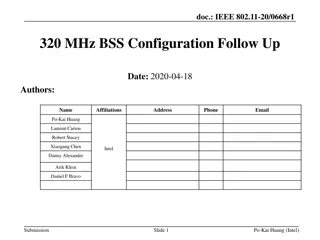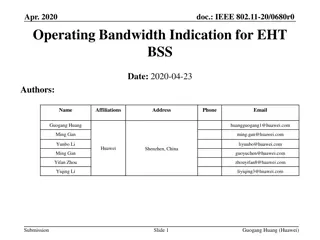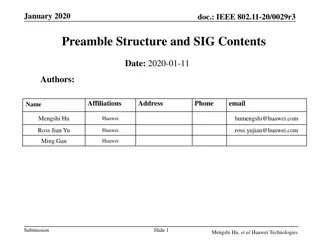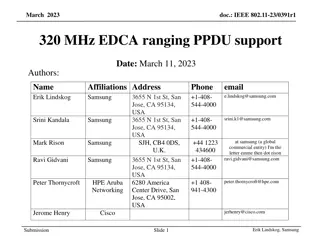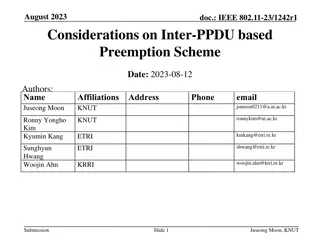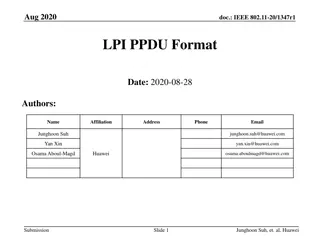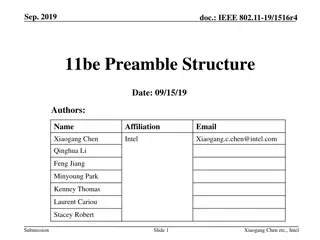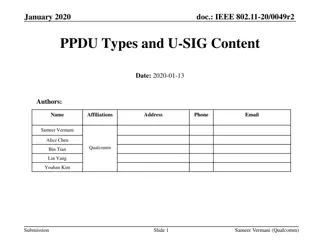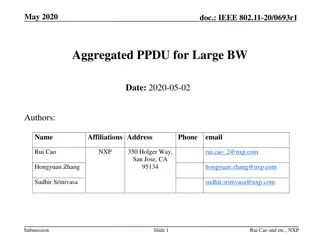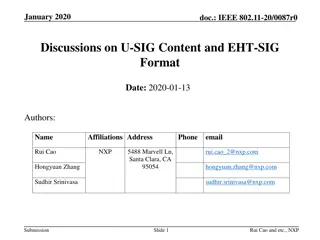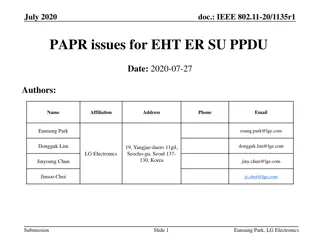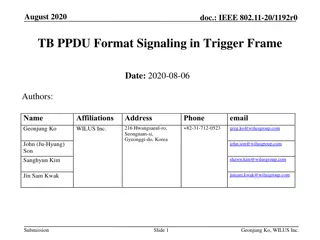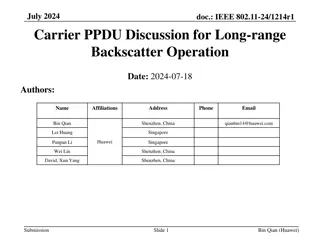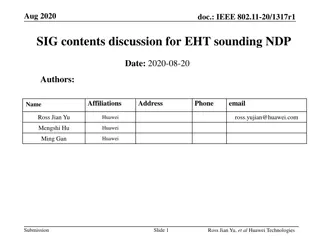IEEE 802.11-23/1067r1 TB Ranging with EHT and HE TB PPDU Overview
This document discusses the use of 320 MHz bandwidth in TB ranging for IEEE 802.11-23/1067r1, focusing on EHT and HE TB frames. It examines the decision trees regarding the use of EHT TB ranging NDP, limitations on frame mixing, and bandwidth reduction for Location Measurement Report (LMR). Key considerations include maintaining frame format consistency and simplifying operations in sequences.
Download Presentation

Please find below an Image/Link to download the presentation.
The content on the website is provided AS IS for your information and personal use only. It may not be sold, licensed, or shared on other websites without obtaining consent from the author. Download presentation by click this link. If you encounter any issues during the download, it is possible that the publisher has removed the file from their server.
E N D
Presentation Transcript
June 2023 doc.: IEEE 802.11-23/1067r1 TB Ranging with EHT and HE TB PPDU Date: 2023-06-20 Authors: Name Christian Berger Affiliations NXP Address 350 Holger Way, San Jose, CA Phone email christian.berger@nxp.com Submission Slide 1 Christian Berger (NXP)
June 2023 doc.: IEEE 802.11-23/1067r1 Use 320 MHz BW in TB Ranging Requires the creation of the EHT TB Ranging NDP Open questions Can we mix EHT and HE TB frames (poll/sound/report)? Review of Facts 11be does not allow mixing non-EHT (HE) and EHT TB operation (in the same TF/RU allocation) Submission Slide 2 Christian Berger (NXP)
June 2023 doc.: IEEE 802.11-23/1067r1 Decision Tree 1. Do we allow use of EHT TB Ranging NDP for 320 MHz only? Yes: Limit number of combinations to reduce testing/implementation No go to slide (7) This means polling and sounding will solicit either EHT TB PPDUs when using 320 MHz BW, or HE TB PPDUs when using < 320 MHz BW Submission Slide 3 Christian Berger (NXP)
June 2023 doc.: IEEE 802.11-23/1067r1 Overview of TB Ranging EHT frames Frequency Location Measurement Report Part 320 MHz ISTA-to-RSTA LMR RSTA-to-ISTA LMR Measurement Sounding Part Polling Part LMR for ISTA1 LMR from ISTA1 TF Ranging Report Time LMR for ISTAn LMR from ISTAn SIFS SIFS SIFS SIFS Christian Berger (NXP) Submission Slide 4
June 2023 doc.: IEEE 802.11-23/1067r1 Decision Tree 2. Do we keep allowing to reduce bandwidth for LMR? Yes, to keep in line with 11az No, done all frames are either EHT or HE (no mixing) This means R2I LMR can be transmitted as either EHT MU PPDU or HE SU/MU PPDU IR2 LMR can be transmitted as either EHT TB PPDU or HE TB PPDU Submission Slide 5 Christian Berger (NXP)
June 2023 doc.: IEEE 802.11-23/1067r1 Decision Tree 3. Do we want all frames in same sequence to be either HE or EHT Yes, to keep it simpler No, allow all combinations or keep EHT for 320 MHz only? This means Keep all frames in the same format in one sequence? IR2 LMR can be transmitted as either EHT TB PPDU or HE TB PPDU Submission Slide 6 Christian Berger (NXP)
June 2023 doc.: IEEE 802.11-23/1067r1 Decision Tree Follow up to (1.) If we allow frames < 320 MHz in EHT format Keep sequences all EHT or all HE Submission Slide 7 Christian Berger (NXP)
June 2023 doc.: IEEE 802.11-23/1067r1 Strawpoll 1. If TB Ranging starts with 320 MHz, keep 320 MHz bandwidth occupied throughout (all frames EHT format ) 2 votes If TB Ranging starts with 320 MHz (can reduce bw), then all frames shall be EHT format 7 votes Any frame that occupies 320 MHz is EHT format , for 160 MHz or less all frames use HE format 3 votes 2. 3. In all options (320 MHz case), TF Poll is EHT MAC format, reply is EHT TB PPDU TF Sounding is EHT MAC, reply is EHT TB Ranging NDP Ranging NDP-A occupies 320 MHz (non-HT duplicate or EHT PHY PPDU), R2I NDP is EHT Ranging NDP Frames determined by this straw poll R2I LMR can be HE MU PPDU (or SU) or EHT MU PPDU EHT Format TF Reporting cab be MAC format HE or EHT (EHT Format) I2R LMR can be HE TB PPDU or EHT TB PPDU (EHT Format) Submission Slide 8 Christian Berger (NXP)



